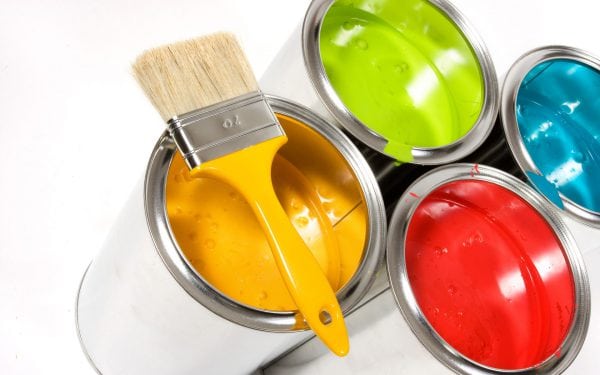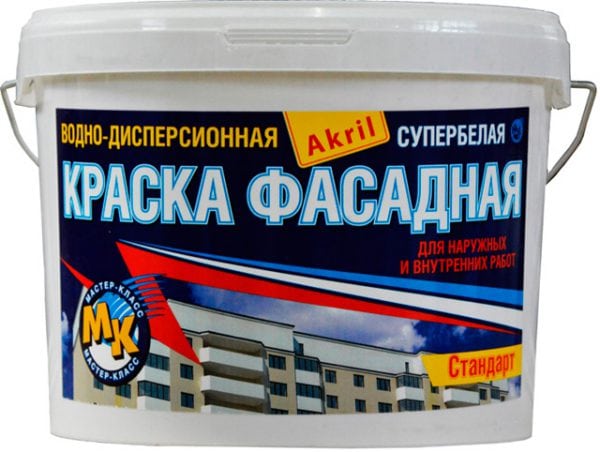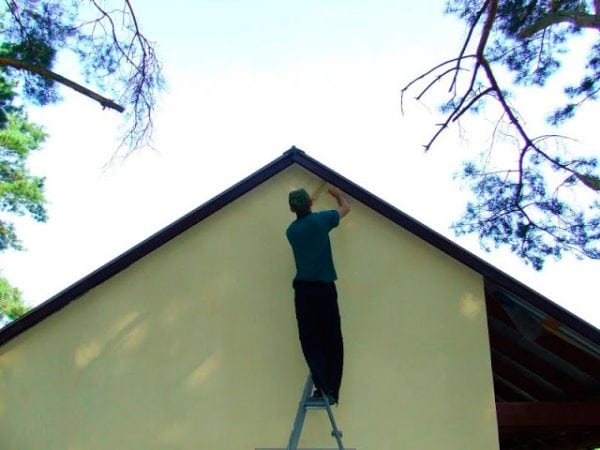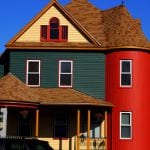The pediment is the upper (final) part of the facade of the house, depending on the design of the roof, it can have a different shape. Often it is faced with wood or wood-like materials, even in private stone buildings. The main task of the gables is to protect the attic from the harmful atmospheric effects (rain, snow, wind). But one cannot exclude the decorative component. Therefore, great importance is attached to the finishing of gables, that is, painting.

The choice of front paint for the pediment
When choosing a suitable topcoat, these points should be considered.
- What is the type of base materials.
- Total amount of work: area, number of layers.
- Type of paint, consumption and other technical characteristics, operational features.
- The financial ability of the consumer (some facade paints are quite expensive, but very, very reliable).
As already mentioned, before painting, it is necessary to apply a primer. This stage of the facade decoration should not be overlooked, since priming mixtures perform several important functions:
- increase the protective properties of paint;
- improve adhesion of the paint to the surface of the base;
- reduce finish coverage.
As for the paint, it should be a material intended for facade work. And this means that the maximum inertness to the aggressive influence of atmospheric phenomena is mandatory.

The fronts of the houses are painted with the following colors:
- Alkyd - are made on the basis of natural oils and synthetic low molecular weight substances (polymers). A strong, moisture-resistant film is formed on the surface of the base, slightly susceptible to abrasion and mechanical stress. The coating is relatively durable, if all the details of staining during operation are observed. However, the paint fades and burns out over time.
- Oily - based on natural or artificial oils. A strong, waterproof film is formed on the surface of the base, but it is vapor permeable. Such paints are characterized by good resistance to mechanical stress. However, they are not among the long-lasting protective coatings, as under the influence of sunlight and heat, they peel off and burn out. Therefore, recently, for outdoor works they are used less often, although they are affordable.
- Silicone is the modern word in painting the house outside. A strong but flexible film forms on the surface of the base due to the unique micropore structure that allows the walls to “breathe”. Along with this, such paints are hydrophobic. The material interacts well with other finishing materials. The result of the work is always positive (without marriage). It is necessary to highlight such positive qualities as antistatic (repulsion of dirt) and antibacterial properties (protection against fungus and mold).In addition: durability, non-susceptibility to fading, peeling and crumbling, tolerance of acid-base effects, non-flammability and fire safety, heat resistance, non-toxicity. If you wish, you can always update or completely change the color of the coating: fresh paint lays well on top of the old.
- Latex.
- Polyvinyl Acetate.
- Acrylic

The last three varieties are more often combined into a group of aqueous dispersions, although commercially available compounds on organic solvents are commercially available. Water dispersion mixtures are preferred because of their environmental friendliness. Among the positive characteristics, we single out the non-susceptibility to environmental influences, hydrophobicity, and durability. Such paints are often called "breathable", since they form a vapor-permeable protective film on the facade of the house.
A significant drawback of aqueous dispersions is their low resistance to mechanical stress and a tendency to rapid abrasion. If you consider that the pediments in the process of operation rarely fall under such an impact, then these funds are in our case the most suitable.
Professional builders give preference to alkyd and latex compounds, as along with amazing protective properties, the materials are represented by a large selection of colors and shades. Painting can be done with one of the traditional painting tools - brush or roller. Specialists often resort to mechanized methods of painting using special spray guns.
to contents ↑Performance of work
You need to buy enough paint to make it enough to paint the pediments of the house in several layers. The purchase volume is determined as follows:
- Measured surface area.
- The value of the area is multiplied by the average consumption of the selected paint (see technical characteristics in the column "consumption" - ml / m2).
- The result is multiplied by the number of layers (at least two).

It is recommended to mix the paint well before use. Note that the viscosity of the substance is also important. So more liquid solutions form a layer thinner than thick, but at the same time the protective properties do not decrease. In the same technical characteristics of the product, you can get information about the possibility of dilution of the working mixture.
We pay attention to the value of the working temperature and weather conditions, since painting work is carried out on the street.
When applying one coat, it is not recommended to take long breaks. In order not to wash the tool every time, it can be wrapped with polyethylene (then the paint will not dry).
Subsequent layers are applied only after the previous one has completely dried, except in cases where shorter waiting periods are allowed. To avoid smudges, work should begin from the top of the pediment, gradually descending. More often, coloring begins with the processing of the perimeter. Smears are made both vertically and horizontally.
Use gloves to prevent solution from getting on your skin. And indeed, personal protective equipment is never superfluous.
Please note that the color of the working solution and the dried coating will be slightly different. This should be considered when tinting of the coloring mixture.
Painting all or individual elements of the facade of the building is a laborious issue, often requiring a competent approach to business. Finally, we add, if you are not sure that you can paint the house yourself, entrust this task to qualified builders. They will be able to choose the best materials, and the exterior will be done at a high professional level.





